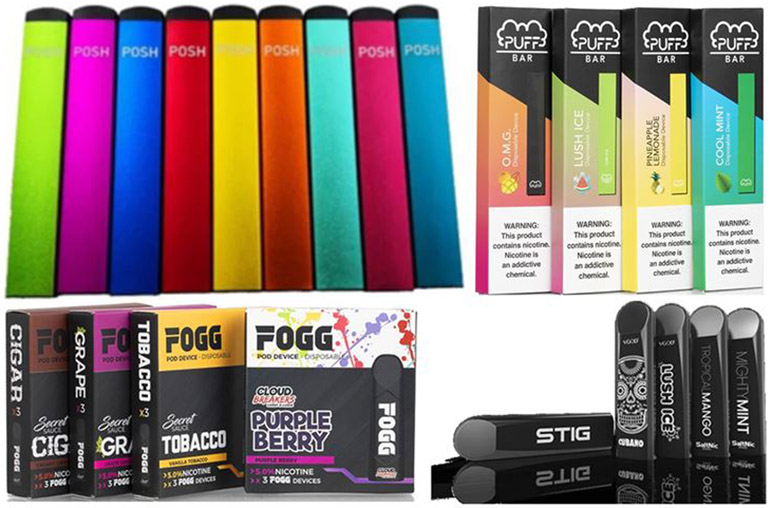For the first few years of the vaping epidemic, to draw in smokers, the tobacco industry provided disposable “try it and throw it out” cigalike electronic cigarettes (e-cigarettes), potentially driven by desire to convince people to try a new product that looked similar to cigarettes with a low initial cost – about the same as (or less than) a pack of cigarettes;[1] much less than a typical reusable e-cigarette starter kit. As vaping became more widespread and normative and users moved into larger tank and mod style e-cigarettes,[2] there was less need to persuade people to try e-cigarettes with a disposable product. Moreover, their availability from online vendors became more scarce and expensive, with the proportion of online vendors selling disposable e-cigarettes dropping from 55.2% in 2013[1] to 23.6% in 2016 (Williams, R. Internet Tobacco Vendors Study, Unpublished Data, 2016), with only 6 of the 98 most popular online vendors selling disposable e-cigarettes in our 2014 purchase study.[3] With this shift, vendors often grouped disposables in multipacks or priced them higher than starter kits in an apparent effort to start people with refillable instead of disposable products, encouraging them toward habitual use.
As the industry moved away from disposable cigalike products, JUUL entered the market in 2015 and, within 3 years, secured a 75% e-cigarette market share.[4] Its broad popularity led to an abundance of small and large brand JUUL-like devices trying to capitalize on JUUL’s popularity, and now, a resurgence of disposable products, this time modeled after JUUL and referred to by sellers as “Disposable Pod Devices” (referring to the pod style e-liquid containers that started with JUUL and now are found in a wide array of JUUL-like devices). These products (Figure 1) are easily found online with a simple Google search, returning 31 brands of products within the first results page, priced as low as $4.60 with up to 7% nicotine (a higher concentration than JUUL) and advertising 200 puffs. This makes them substantially cheaper than JUUL pod refill 4-packs and certainly a cheaper means for trying JUUL-like devices than buying a full starter kit (which costs $49.99 from JUUL.com, and may be difficult for some youth to afford to try out). Furthermore, age verification practices of these device’s sellers are questionable, with some relying on unenforceable statements that by buying the products you are certifying you are over 18.
Figure 1.
Example of several brands of “Disposable Pod Devices”, which look much like JUUL
These disposable products may surge in popularity with minors and prompt users of all ages to try and become addicted to vaping when they might not have tried it otherwise due to the cost of entry. Moving forward, it is critical to carefully observe how these disposable products are marketed and to whom, and how rigorous sellers are about preventing youth access. Doing so is key to restricting these vendors’ access to new users who may become addicted to vaping, which may lead to smoking.[5, 6] Future regulatory and enforcement efforts should pay special attention to these products, which may have even more youth appeal than JUUL, due to their low cost.
Acknowledgements:
This work was funded by grant 5R01CA169189 from the National Cancer Institute.
Role of the funding source: The National Cancer Institute had no role in the design and conduct of the study; collection, management, analysis, and interpretation of the data; preparation, review, or approval of the manuscript; nor decision to submit the manuscript for publication.
References
- [1].Williams RS, Derrick J, Liebman AK, et al. Content analysis of e-cigarette products, promotions, prices and claims on Internet tobacco vendor websites, 2013-2014. Tob Control 2017. [DOI] [PMC free article] [PubMed] [Google Scholar]
- [2].Herzog B, Gerberi J. E-cigs revolutionizing the tobacco industry. Wells Fargo Securities 2013. [Google Scholar]
- [3].Williams RS, Derrick J, Ribisl KM. Electronic Cigarette Sales to Minors via the Internet. JAMA Pediatrics 2015;169(3):e1563. [DOI] [PMC free article] [PubMed] [Google Scholar]
- [4].The Truth Initiative. Behind the Explosive Growth of JUUL: Social Influences and Flavors Drive Rising Teen Use of the Top E-Cigarette. Washington, D.C: 2018. [Google Scholar]
- [5].Chatterjee K, Alzghoul B, Innabi A, et al. Is vaping a gateway to smoking: a review of the longitudinal studies. Int J Adolesc Med Health 2016;30(3). [DOI] [PubMed] [Google Scholar]
- [6].Miech R, Patrick ME, O'Malley PM, et al. E-cigarette use as a predictor of cigarette smoking: results from a 1-year follow-up of a national sample of 12th grade students. Tob Control 2017;26(e2):e106–e111. [DOI] [PMC free article] [PubMed] [Google Scholar]



